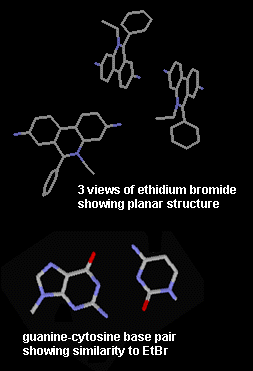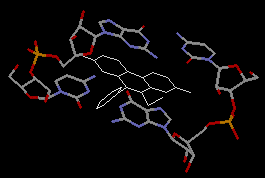This is a Guanine-Cytosine base pair. When they are aligned with
each other in the double helix of DNA, they form a planar structure
On the left is a stick model of two base pairs stacked on top of each other.
On the right is a space-filling model of the same two base pairs. Note:
There is an empty space between the two base pairs!
 Ethidium
bromide is a fluorescent molecule, composed of 4 rings. Three of
the rings form a planar structure. On the left this structure is
shown in several different views. The steric similarity to a purine-pyrimidine
base pair is obvious!
Ethidium
bromide is a fluorescent molecule, composed of 4 rings. Three of
the rings form a planar structure. On the left this structure is
shown in several different views. The steric similarity to a purine-pyrimidine
base pair is obvious!

Because ethidium bromide is planar, and sterically similar to a base pair,
it
can fit in the space between 2 adjacent base pairs of the helix.
This is called intercalation.
An example of DNA bands
on an agarose gel which have been stained with ethidium bromide. The numbers
indicate the size of the DNA fragments in base pairs (bp).